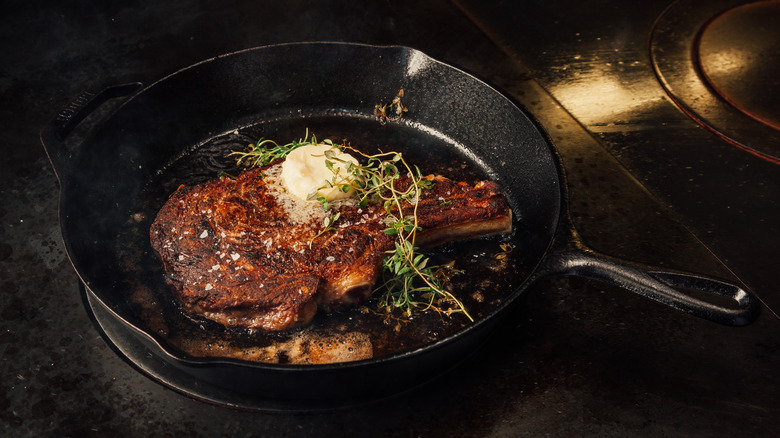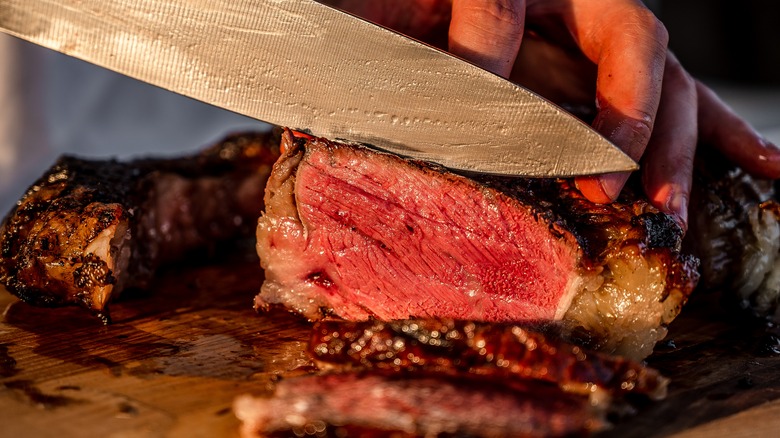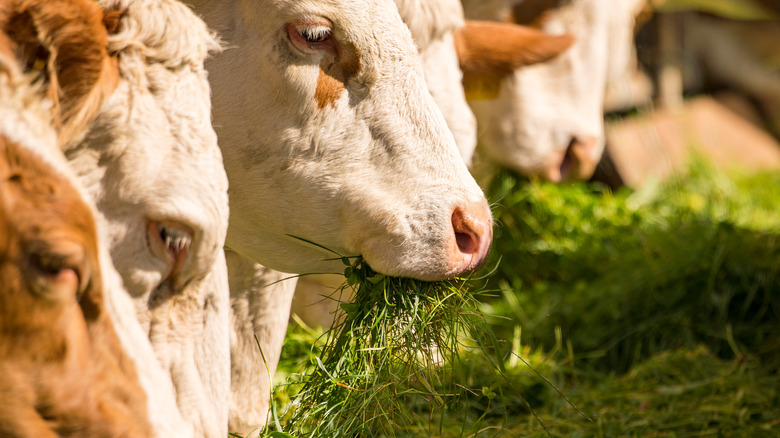The Proper Way To Cook Grass-Fed Beef Without Ruining It
Once only found on health food store shelves, grass-fed beef is now a mainstay meat option. The grass-fed beef market is forecasted to surpass $13 billion in revenue globally by the end of 2025, according to a July press release from Fairfield Market Research.
Grass-fed beef comes from cows that eat — you guessed it — grass. Conventional cattle, which we are historically most familiar with, feeds on corn, soy, and other by-products. The differences in diet affect the fat content of the meat, as well as its flavor and texture. Many people find grass-fed meat has a stronger, more earthy or gamey taste when compared to conventional steak, explains the Chicago Steak Company.
Not only does the diet of the cow affect the nutritional composition and flavor of the beef, but it also requires slightly modified cooking techniques. If you're investing in a quality piece of grass-fed meat, what's the best way to prepare it to ensure you end up with a juicy, tender piece of beef?
How to cook grass-fed beef
Due to its lower fat content, grass-fed beef is easy to overcook. That beautiful, nutrient-dense steak will quickly cross the line from tender to tough much faster than conventional beef does. Thankfully, it just takes a little know-how and proper technique to save that high-quality steak from ruin.
The first thing to keep in mind is temperature. The Organic Butcher suggests cooking grass-fed beef at a temperature 50 degrees lower, at minimum, than what you'd normally cook conventional beef. They also suggest relying on a meat thermometer to gauge the meat's doneness. Grass-fed steak isn't meant to be cooked to well-done; it's best enjoyed rare or medium-rare, per the American Grassfed Association. Another element to note is time — that includes how long you cook the meat as well as the rest time before you cut into it. The lower quantity of fat will cook off quickly, leaving you with a much drier and tougher steak than a conventionally fed cow cooked for the same amount of time.
Lastly, the cut of beef you're working with comes into play. Ground beef is pretty forgiving and hard to mess up. It's easy to drizzle a cooking fat in the pan or add in onions and sauces. Grass-fed steaks, meanwhile, require a shorter cook time than grain-fed due to the lower fat. Any roasts are best cooked low and slow — at a low temperature, for a longer time.
The health benefits of grass-fed beef
You're probably familiar with the idiom "you are what you eat." But we may want to take it one step further and consider the possibility that "you are what you eat, eats."
Beef in and of itself is an excellent source of protein and iron, as well as other important vitamins and minerals, but grass-fed beef has some extra health benefits on offer. Gram-for-gram, it contains fewer calories and has much less fat than conventionally-fed cattle. It also contains up to five times the amount of heart-healthy omega-3 fatty acids as grain-fed cows (per WebMD).
"Grass-finished" also pops up amongst the myriad of labels on the meat shelf. This simply means the cow ate grass for the duration of its life up until slaughter. Per South Dakota State, the U.S. Department of Agriculture's laws allow any cattle fed grass for 50% of its life to don the grass-fed label. A study published in the journal Meat Science in 2004 found the vitamin E content in grass-finished cows to be higher than those fed a mixed diet of grain or soy.


